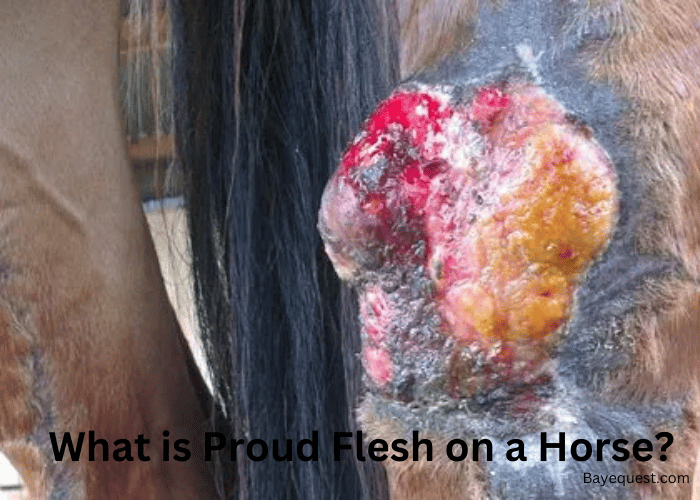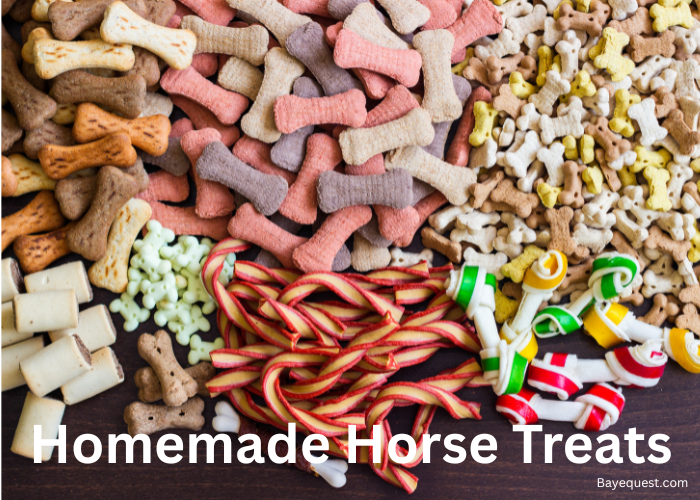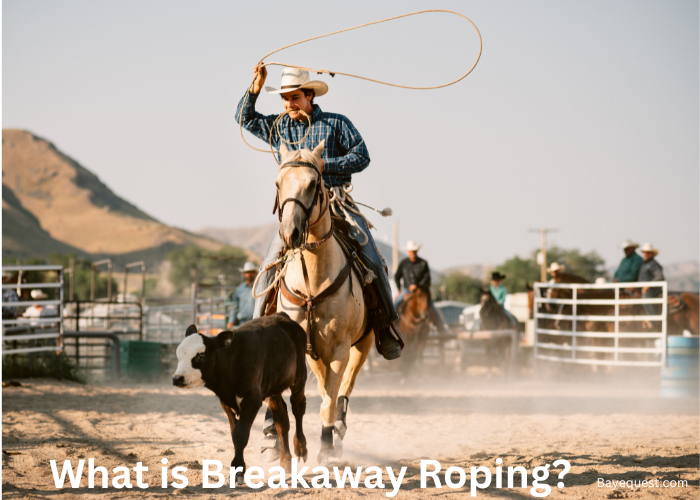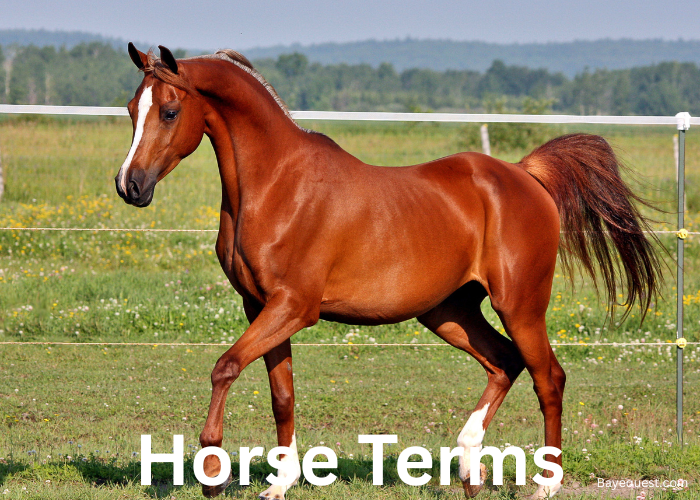Wounds on a horse can be tricky. Just when you think it’s healing, something unexpected can happen.
Some wounds seem to take on a life of their own, making it harder for the skin to close up properly.
This isn’t just frustrating—it’s a challenge every horse owner needs to know about. So, what’s really going on beneath the surface?
Let’s dive in and uncover one of the most common healing hurdles horses face.
What is Proud Flesh on a Horse? Key Takeaway
Proud flesh, or excessive granulation tissue, is a common issue in horse wound healing. It appears as a raised, pink mass that hinders skin closure. Typically seen in high-movement areas, it’s not painful but delays recovery. Proper wound care and early treatment are essential to prevent and manage proud flesh effectively.
What is Proud Flesh in Horses?
Proud flesh, scientifically known as Exuberant Granulation Tissue (EGT), develops when a wound produces more tissue than necessary during the healing process.
Normally, granulation tissue plays a vital role in wound repair. It fills the wound, provides a surface for new skin cells, and protects against infection.
However, in some cases, the body overproduces this tissue, causing it to extend beyond the wound edges.
This results in a raised, uneven mass that can hinder the final stages of healing.
The horse skin condition is most common in areas with high movement, like a horse’s lower legs, where skin closure takes longer.
Proud flesh lacks nerve endings, so it doesn’t cause pain directly. However, it has a dense network of blood vessels, making it prone to bleeding with minor contact.
The overgrowth prevents the surrounding skin from covering the wound, prolonging the healing process.
In severe cases, proud flesh can also increase the risk of infection, as the exposed tissue is more vulnerable to contaminants.
This is why managing wounds properly from the start is crucial to prevent this condition from developing.
Signs and Symptoms of Proud Flesh in Horses
When a horse’s wound isn’t healing as expected, proud flesh might be the culprit.
Recognizing the signs early can make all the difference in managing this stubborn tissue and keeping the healing process on track.
Here’s what to watch for.
1. Raised, bulky tissue
Proud flesh appears as a raised mass that extends above the level of the surrounding skin. It often looks like a lumpy, uneven growth.
2. Pink or red color
The tissue is usually bright pink or reddish due to the high number of blood vessels. This gives it a fleshy, raw appearance.
3. Bleeds easily
Proud flesh is highly vascular, meaning it has many blood vessels. Even minor contact can cause it to bleed.
4. Lack of pain
Despite its appearance, proud flesh doesn’t have nerve endings. This means it doesn’t cause pain, even when touched or disturbed.
5. Delayed wound closure
One of the most noticeable signs is that the wound edges stop progressing toward closure. The excessive tissue growth prevents the skin from covering the wound.
6. No scab formation
Unlike typical wounds, proud flesh doesn’t form a scab. Instead, it remains moist and fleshy.
7. Swelling around the wound
In some cases, there may be mild swelling around the affected area due to irritation or secondary infection.
8. Persistent open wound
Proud flesh keeps the wound open, often for weeks longer than expected, despite other signs of healing.
9. Excessive tissue growth after bandage removal
If a wound was bandaged and proud flesh develops, the excessive tissue may appear more pronounced once the bandage is taken off.
Causes of Equine Proud Flesh
Understanding the causes of proud flesh is key to preventing it.
Let’s break down the most common causes and how they contribute to this condition.
Blood supply
Proud flesh thrives in areas with a rich blood supply.
Wounds in the lower limbs are particularly vulnerable because these regions have dense blood vessel networks.
While blood is essential for healing, excessive vascular growth can lead to uncontrolled granulation tissue.
This results in the overproduction of tissue, which hinders skin from closing over the wound.
Biological imbalances
Healing relies on a delicate balance of cellular activity. When this balance is disrupted, granulation tissue can grow unchecked.
For instance, an overactive immune response may trigger excessive cell production.
Similarly, a deficiency in specific growth factors can prolong the wound-healing phase, encouraging the formation of proud flesh.
Excessive movement
Wounds on areas like the lower legs are exposed to constant movement. Every time a horse walks or shifts weight, the wound stretches.
This repeated motion interferes with the normal healing process, preventing skin edges from coming together.
In response, the body produces more granulation tissue to compensate, often resulting in proud flesh.
Inflammation
Inflammation is a natural response to injury, but prolonged or excessive inflammation can cause problems.
It keeps the wound environment in an active healing phase, stimulating continuous tissue growth.
This persistent state prevents the transition to the next stage of healing, leading to an overgrowth of granulation tissue.
Poor wound management
Proper wound care is crucial to avoid proud flesh.
If a wound isn’t cleaned, bandaged, or monitored correctly, granulation tissue may overgrow.
For instance, leaving a wound exposed in a high-movement area can lead to irritation.
Similarly, applying the wrong types of ointments may encourage tissue proliferation rather than promoting skin closure.
Contamination and infection
A contaminated or infected wound is at high risk of developing proud flesh.
Bacteria and debris in the wound disrupt the natural healing cycle. They cause prolonged inflammation and tissue irritation.
This triggers the body to produce more granulation tissue as a protective barrier, often resulting in proud flesh.
Delayed treatment
Delaying treatment after an injury can give proud flesh a head start.
Wounds that are left unattended for too long begin to develop excessive granulation tissue as the body tries to protect itself.
Early intervention, including cleaning and proper bandaging, is key to keeping this tissue growth under control.
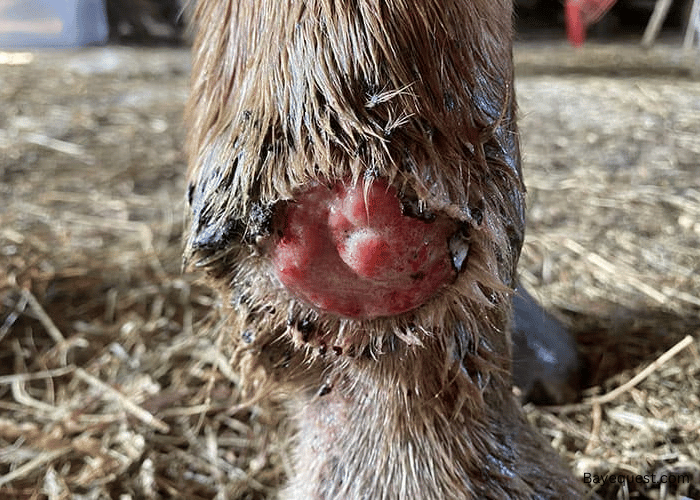
How is Proud Flesh Diagnosed in Horses?
Diagnosing proud flesh involves a combination of methods to confirm its presence and rule out other conditions.
Here’s how vets approach the process:
Measurements
Vets often measure the size and depth of the wound. This helps track tissue growth over time.
If the granulation tissue grows beyond the wound’s surface, it may indicate proud flesh.
Regular measurements allow for better monitoring and evaluation of healing progress.
Visual examination
A visual check is usually the first step. Proud flesh has a distinct appearance—raised, pink or reddish, and uneven.
Vets look for these characteristics, as well as any signs of bleeding or poor wound closure.
The visual clues are often enough to suggest the condition.
Medical history
The horse’s medical history provides valuable context. Vets ask about the wound’s origin, previous treatments, and how long it has been healing.
A history of slow or problematic wound healing increases the likelihood of proud flesh.
Understanding past management helps pinpoint contributing factors.
Skin biopsy
In uncertain cases, a small sample of tissue may be taken for analysis.
A biopsy confirms whether the excessive tissue is granulation tissue or something more serious.
This step is particularly useful if there’s suspicion of abnormal cell growth or infection.
Palpation
Vets may gently feel the tissue to assess its texture. Proud flesh is typically soft and spongy compared to other types of growths.
Palpation also helps determine whether the tissue has nerve endings. The absence of pain when touched is a common sign of proud flesh.
Differential diagnosis
Not all raised tissue in a wound is proud flesh. Here vets rule out other conditions, such as tumors, abscesses, or infected tissue.
This process, called differential diagnosis, ensures the horse gets the correct treatment.
It involves comparing symptoms and, if needed, running additional tests to confirm.
Treatment of Proud Flesh in Horses
Once proud flesh is diagnosed, prompt treatment is essential to restore proper wound healing.
Several methods can be used, depending on the severity of the condition. The methods are:
Medication
Topical treatments, such as steroid creams or ointments, are commonly applied to reduce tissue growth.
These medications help slow down the production of granulation tissue while promoting healthy skin formation.
In some cases, vets may use antibiotics if there’s a risk of infection.
Tissue removal
If the proud flesh is severe, surgical removal may be necessary.
A vet carefully trims away the excessive tissue to bring the wound level with the surrounding skin.
This procedure, called debridement, helps the wound restart the healing process. It’s usually quick and performed under local anesthesia.
Skin grafting
In extreme cases where proud flesh has hindered natural skin growth, a skin graft might be required.
This involves transplanting healthy skin from another area of the horse to cover the wound.
Skin grafting is used for large or slow-healing wounds and requires specialized care during recovery.
Bandaging or casting
Bandages or casts are often used to protect the wound and control movement.
Applying pressure helps limit granulation tissue growth and encourages the wound edges to close.
Regular changes are essential to keep the area clean and prevent complications like infection.
Wound dressing
Specialized wound dressings can aid in controlling proud flesh.
Non-stick dressings are designed to keep the wound moist and promote healing without irritating the tissue.
Some dressings contain medicated components that reduce inflammation and tissue overgrowth, enhancing the healing environment.
Recovery and Management of Equine Proud Flesh
Once proud flesh has been treated, ongoing care is crucial to support healing and prevent recurrence.
Let’s look at the effective ways of managing recovery:
Regular wound monitoring
Close observation is essential to track healing progress. Check the wound daily for any signs of new tissue overgrowth, bleeding, or infection.
Early detection of any changes helps address issues promptly before they worsen.
Gentle cleaning
Keeping the wound clean is vital to avoid infection and encourage healthy healing.
Use a mild antiseptic wash as recommended by your vet, and be gentle to avoid irritating the tissue.
Overly harsh cleaning can slow recovery and trigger new tissue growth.
Controlled exercise
Excessive movement around the wound can slow down recovery, especially for lower leg injuries.
Limit your horse’s activity as advised by your vet.
Light exercise, such as controlled walking, is often recommended to prevent stiffness without stressing the wound.
Bandaging and re-bandaging
Regular bandaging or casting helps protect the wound and encourages skin to close over the area.
Change the bandages as directed by your vet to keep the wound environment clean and to prevent moisture build-up.
This also reduces the risk of proud flesh returning.
Nutritional support
A balanced diet supports the immune system and aids tissue repair.
Ensure your horse has adequate protein, vitamins, and minerals, especially zinc and vitamin C, which play important roles in wound healing.
Supplements may be added as recommended by a vet to boost recovery.
Veterinary check-ups
Routine vet visits allow for professional assessment of healing progress.
A vet can adjust the treatment plan, provide additional wound care guidance, and intervene if proud flesh shows signs of recurrence.
Professional oversight ensures the wound heals properly.
How to Prevent Equine Proud Flesh
Preventing proud flesh starts with proper wound care and proactive management.
The key strategies to keep granulation tissue growth under control include:
Early wound care
Treat wounds immediately to reduce the risk of proud flesh. Clean the wound thoroughly with a mild antiseptic to remove dirt and debris.
Early intervention helps establish a healthy healing environment and prevents excessive tissue growth.
Maintain a clean environment
A clean wound is less likely to develop complications. Keep the injured area free from contaminants by regularly changing dressings and using clean bandages.
Minimize the horse’s exposure to dirt, mud, and other sources of bacteria that could delay healing.
Use proper bandaging
Bandaging plays a critical role in preventing proud flesh. Applying a pressure bandage helps reduce swelling and limits the formation of excessive granulation tissue.
Ensure the bandage is snug but not too tight, and change it frequently to keep the wound clean and dry.
Limit movement
Excessive movement can interfere with wound closure and encourage tissue overgrowth.
Restrict your horse’s activity by using stall rest or controlled exercise, particularly for wounds on high-motion areas like the legs.
This allows the wound to heal more efficiently.
Monitor healing progress
Regularly check the wound to ensure it’s healing properly. Look for any signs of excessive granulation tissue, such as a raised, fleshy appearance.
If you notice proud flesh starting to form, consult your vet immediately to address it early.
Apply topical treatments
In some cases, your vet may recommend using steroid ointments or other topical treatments to prevent granulation tissue from growing too quickly.
These medications help regulate tissue production and promote skin regeneration.
Veterinary guidance
For larger or more complex wounds, seek veterinary advice early.
A vet can provide specific care instructions, recommend the best treatment methods, and monitor the wound to prevent complications like proud flesh from developing.
Equine Proud Flesh in Horses Vs Ponies
Proud flesh can affect both horses and ponies, but there are some differences in how it develops and is managed.
Horses are more prone to proud flesh, especially on their long, slender legs where wounds heal slowly.
Ponies, on the other hand, tend to heal faster due to their thicker skin and stronger immune response.
This makes them less likely to develop excessive granulation tissue.
However, when proud flesh does occur, treatment methods like debridement, bandaging, and topical medications are similar for both.
The key difference lies in prevention, as ponies may need less intervention to keep wounds under control compared to horses.
Wound Healing Process in Horses
The wound healing process in horses involves four key stages. Each stage plays a vital role in repairing damaged tissue.
Let’s take a deeper look at each stage:
1. Hemostasis
This is the body’s immediate response to injury. When a wound occurs, blood vessels constrict to minimize blood loss.
Platelets rush to the site and form a clot, which serves as a temporary barrier.
The clot not only stops bleeding but also releases growth factors that kickstart the healing process.
2. Inflammation
Inflammation begins shortly after hemostasis and lasts for a few days. White blood cells, mainly neutrophils and macrophages, migrate to the wound.
Neutrophils help clear bacteria and debris, while macrophages remove dead cells and release cytokines.
These signals attract more immune cells and stimulate tissue repair. The wound may appear swollen, warm, and slightly red during this phase, which is normal.
3. Proliferation
This phase involves the formation of new tissue.
Fibroblasts, a type of connective tissue cell, move into the wound and produce collagen. Collagen provides structural support and strengthens the wound.
At the same time, endothelial cells form new blood vessels in a process called angiogenesis, which restores oxygen and nutrients to the area.
Granulation tissue fills the wound, creating a foundation for epithelial cells to grow and cover the wound.
4. Maturation (Remodeling)
The final phase can last several weeks to months. Collagen fibers are reorganized and cross-linked to increase the wound’s tensile strength.
Type III collagen, initially produced during the proliferation phase, is replaced by stronger Type I collagen.
The new skin continues to mature, and blood vessels formed during angiogenesis regress.
Over time, the scar tissue becomes less visible and more similar to the surrounding skin, although it may never regain full strength.
FAQs
Can proud flesh heal on its own?
Proud flesh rarely resolves without intervention. Once excessive granulation tissue forms, it prevents the wound from closing properly. Treatment, such as trimming or using topical medications, is usually required to restore normal healing.
Is proud flesh painful for the horse?
No, proud flesh itself is not painful because it lacks nerve endings. However, the surrounding wound can be sensitive, and excessive tissue may bleed easily, causing discomfort during treatment or cleaning.
How long does it take to heal after treatment?
The healing time depends on the wound’s size, location, and the treatment used. In general, it can take several weeks to a few months for the wound to heal fully after proud flesh is removed.
Conclusion
Proud flesh can turn a simple wound into a frustrating challenge, but it doesn’t have to be overwhelming.
With the right care and a little patience, your horse can heal properly and get back to feeling its best.
Whether it’s managing wounds or working with your vet, staying proactive makes all the difference.
Remember, every step you take toward better wound care helps prevent proud flesh and keeps your horse healthy and happy.
Next, check out our guide on preventing stifle injuries in horses because strong joints are just as important as healthy skin.




